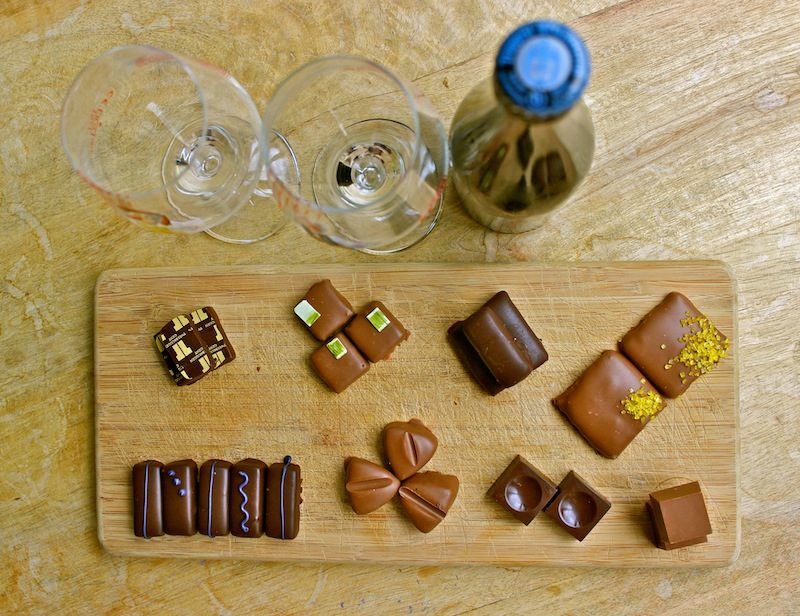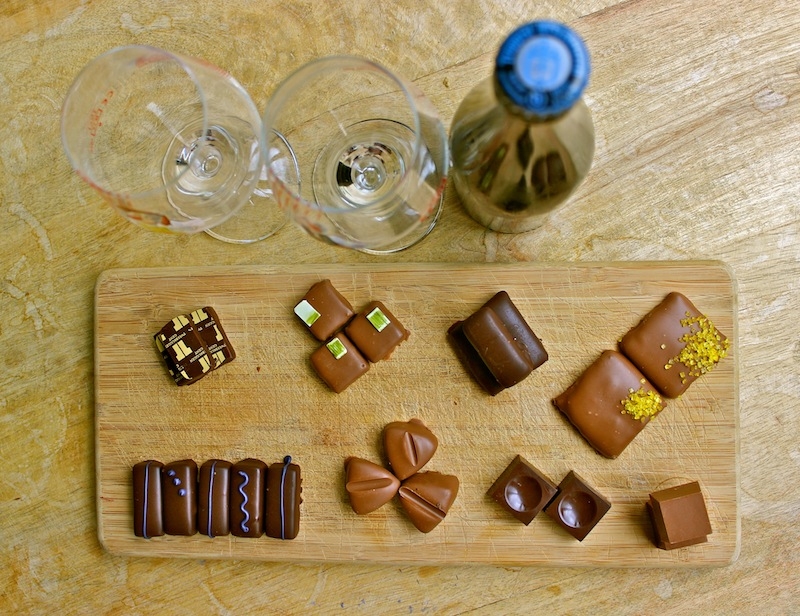In one of my recent chocolate classes we were tasked as a group of fifteen students to make a series of new and experimental pralines. It’s important for us as budding chocolatiers to try out new things – if not to discover new tastes then at least to appreciate combinations used in the world of Belgian chocolates which are not regarded as classic.
WHAT IS A PRALINE?
The term ‘praline’ can differ in meaning depending on which country you are in, but in Belgium, a ‘praline’ consists of a hard chocolate shell with a softer, sometimes liquid filling.
This filling can be cream based (ganache) or nut based (praliné). Ganache is a filling generally made from chocolate and cream but also from other substances such as our more experimental ingredients. Praliné involves caramelising nuts which are then ground into a paste and used as a filling and sometimes mixed with other ingredients.
Traditional pralines contain fillings made from butter, liquor, nuts, marzipan and chocolate itself, each of which acts to complement the outer shell of harder chocolate.
WHY ARE OUR PRALINES ‘EXPERIMENTAL PRALINES’?
What was special about the experimental pralines we made here was that they were all made with either ethereal oils or infusions.
Ethereal (or ‘essential’) oils are liquids that are distilled from parts of a plant. They are highly concentrated so great care must be taken with them not to overpower the taste of the chocolate. As ethereal oils contain a lot of fat, it is also important to keep an eye on the percentage of fat in the ganache and to remember to always add the ethereal oils at the very end. By doing this, you capitalise on the aromas they bestow on the chocolates. However, be mindful that the aroma escapes quickly once heated.
Infusions are made by infusing tea, herbs or bark in a boiling liquid (take your pick from water, cream, milk or juice). You can let the mix infuse for a night, or if you want to work more quickly you can boil your mix and infuse it for a few minutes. You then should have sufficient aroma to make a great tasting praline.
It was important for us that the appearance of each of the experimental pralines reflected its ingredients and had its own unique character. So we paid great attention to the creation of the outer chocolate shells in which the various ganache fillings were to be embedded. For some pralines, we used a chocolate mould, into which we poured the chocolate to create the outer layer, and then added in the ganache. For others, we used a dipping fork for gently dipping the ganache into the chocolate. We did this by delicately balancing the ganache on the dipping forks.
Here are the seven experimental pralines made with ethereal oils or infusions that we put together in class:
1. GRAPEFRUIT PRALINE (ethereal oil)
Chocolate: Milk
Ingredients: cream (200g), trimoline (25g), butter (25g), milk chocolate (150g), dark chocolate (175g), grapefruit oil (4 drops), citrus sugar
Size: 4cm x 4cm
Technique: Dipping fork
Tasting Notes: As you can see from the picture, the flattened square shape with colourful citrus sugar makes this praline stand out visually. There’s a very pleasant fruitiness in taste and the tropical nature of the grapefruit flavours complement the sweetness of the milk chocolate. This one has a lovely full texture.
2. PEPPERMINT PRALINE (ethereal oil)
Chocolate: Milk
Ingredients: base cream = 1l cream and 4dl condensed milk (200g), glucose (25g), dark chocolate (325g), mint oil (5 drops)
Size: 2cm x 2cm
Technique: Dipping fork
Tasting Notes: These experimental pralines each had a small square-shaped decoration on top of one of their corners. The tiny green and white palettes were made by spreading white chocolate out on a tray and painting them with some edible colouring. It’s almost like they’re wearing a little peppermint bow tie, getting ready for their introduction after dinner. Refreshing. Cool. And sophisticated.
3. LAVENDER PRALINE (infusion)
Chocolate: Dark
Ingredients: milk chocolate (250g), lavender (4g), cream (175g), invert sugar (10g), butter (35g)
Size: 1cm x 4cm
Technique: Dipping fork
Tasting Notes: These pralines are presented with navy blue purplish designs crafted with a squeeze-bag containing some coloured chocolate. Their taste is very much lavender but not overpoweringly so. The infusion was made out of real lavender from the garden of the school. They’ve got a creamy consistency and the bitter dark chocolate flavours make their way to the fore in the aftertaste.
4. JASMINE TEA PRALINE (infusion)
Chocolate: Dark
Ingredients: milk chocolate (250g), jasmine tea (4g), cream (175g), invert sugar (10g), butter (35g)
Size: 2cm x 2cm
Technique: Mould
Tasting Notes: The swimming pool cavity on the top of this praline is not a container from which to drink tea – jasmine or otherwise. This praline is dominated by the dark chocolate taste but its not easy to detect the jasmine tea. Perhaps the infusion wasn’t carried out for long enough?
5. LIQUORICE PRALINE (infusion)
Chocolate: Milk
Ingredients: cream (200g), invert sugar (15g), liquorice (chopped fine: 40g / powder: 15g), dark chocolate (400g)
Size: 2.5cm (triangular)
Technique: Dipping fork
Tasting Notes: Liquorice is a sweet tasting root of the Glycyrrhiza glabra plant, a legume native to Southern Europe and parts of Asia. It is often used for infused teas or to chew on for taste. To suggest our deployment of the liquorice ‘straw’ in its appearance, we used a small piece of plastic straw to make an indent in the top of this praline after our dipping. The result of the infusion was a very light liquorice taste.
6. FRESH ROSEMARY PRALINE (infusion)
Chocolate: Dark
Ingredients: base cream (200g), invert sugar (25g), butter (25g), milk chocolate (150g), dark chocolate (175g), rosemary (4g)
Size: 1cm x 3cm
Technique: Dipping fork
Tasting Notes: Unlike many of the other infused pralines, the strong herb aroma on approach was evident immediately. In the mouth it’s a little bit spicy and fresh with a creaminess in texture. The design on the praline is the result of a ‘transfer’ which CVO Leerdorp had made especially for the school. A ‘transfer’ is a plastic sheet you place over the chocolate and which reveals a print on the chocolate when removed.
7. ROSEMARY DROPS PRALINE (ethereal oil)
Chocolate: Dark
Ingredients: base cream (200g), invert sugar (25g), butter (25g), milk chocolate (150g), dark chocolate (175g), rosemary oil (3 drops)
Size: 1cm x 4cm
Technique: Dipping fork
Tasting Notes: This praline, with its longer body and narrower girth, offered a stronger taste of rosemary than the infused fresh rosemary version. It also felt very different in the mouth, having a more liquid texture in the middle and as a result developed a different relationship with the tongue.
FAVOURITES IN A TASTING
We had some visitors to Ghent last weekend so the four of us sat down to conduct a tasting of all of the above experimental pralines.
As this blog explores the taste of Belgian beer as well as Belgian chocolate, we decided to combine the tasting of the chocolates with a Westvleteren 8 – a hazy amber Trappist dubbel of 8% ABV. It’s got a rich malty complexity and some cherry, raisins and fig in the nose and its full body made for some interesting combinations with the experimental pralines.
The general consensus was that the stronger tasting experimental pralines such as the grapefruit and peppermint ones were the best – perhaps due to the difficulty of producing herb based ganache with enough flavour to be noticed but not so much as to overpower the chocolate. It’s easier to make and eat a praline with too much grapefruit flavour as opposed to one which is dominated by a strong lavender or rosemary taste.
Which one of the above would you choose to eat if they were sitting in front of you?
Which experimental pralines would you like to see created?




